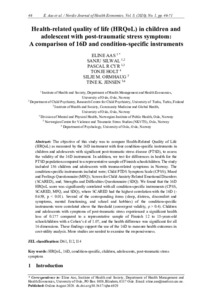Health-related quality of life (HRQoL) in children and adolescent with post-traumatic stress symptom: A comparison of 16D and condition-specific instruments
Tine K Jensen; Sanju Silwal; Tonje Holt; Eline Aas; Silje M Ormhaug; Pascal Renee Cyr
https://urn.fi/URN:NBN:fi-fe2021042825683
Tiivistelmä
The objective of this study was to compare Health-Related Quality of Life (HRQoL) as measured by the 16D instrument with four condition-specific instruments in children and adolescents with significant post-traumatic stress disease (PTSD), to assess the validity of the 16D instrument. In addition, we test for differences in health for the PTSD population compared to a representative sample of Finnish schoolchildren. The study included 156 children and adolescents with trauma-related symptoms in Norway. The condition-specific instruments included were; Child PTDS Symptom Scale (CPSS); Mood and Feelings Questionnaire (MFQ); Screen for Child Anxiety Related Emotional Disorders (SCARED), and; Strengths and Difficulties Questionnaire (SDQ). We found that the 16D HRQoL score was significantly correlated with all condition-specific instruments (CPSS, SCARED, MFQ, and SDQ), where SCARED had the highest correlation with the 16D (-0.659, p < 0.01). Several of the corresponding items (sleep, distress, discomfort and symptoms, mental functioning, and school and hobbies) of the condition-specific instruments were correlated above the threshold (convergent validity, ρ > 0.4). Children and adolescents with symptoms of post-traumatic stress experienced a significant health loss of 0.177 compared to a representative sample of Finnish 12 to 15-years-old schoolchildren with a Cohen’s d of 1.07, and the health difference was significant for all 16 dimensions. These findings support the use of the 16D to measure health outcomes in cost-utility analysis. More studies are needed to examine the responsiveness.
Kokoelmat
- Rinnakkaistallenteet [19204]
